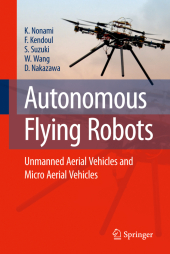 Neuerscheinungen 2014Stand: 2020-02-01 |
Schnellsuche
ISBN/Stichwort/Autor
|
Herderstraße 10
10625 Berlin
Tel.: 030 315 714 16
Fax 030 315 714 14
info@buchspektrum.de |

Farid Kendoul, Kenzo Nonami, Satoshi Suzuki
(Beteiligte)
Autonomous Flying Robots
Unmanned Aerial Vehicles and Micro Aerial Vehicles
2010. 2014. xvii, 329 S. 10 Tabellen. 235 mm
Verlag/Jahr: SPRINGER, BERLIN; SPRINGER JAPAN; SPRINGER 2014
ISBN: 4-431-54687-1 (4431546871)
Neue ISBN: 978-4-431-54687-0 (9784431546870)
Preis und Lieferzeit: Bitte klicken
The advance in robotics has boosted the application of autonomous vehicles to perform tedious and risky tasks or to be cost-effective substitutes for their - man counterparts. Based on their working environment, a rough classi cation of the autonomous vehicles would include unmanned aerial vehicles (UAVs), - manned ground vehicles (UGVs), autonomous underwater vehicles (AUVs), and autonomous surface vehicles (ASVs). UAVs, UGVs, AUVs, and ASVs are called UVs (unmanned vehicles) nowadays. In recent decades, the development of - manned autonomous vehicles have been of great interest, and different kinds of autonomous vehicles have been studied and developed all over the world. In part- ular, UAVs have many applications in emergency situations; humans often cannot come close to a dangerous natural disaster such as an earthquake, a ood, an active volcano, or a nuclear disaster. Since the development of the rst UAVs, research efforts have been focused on military applications. Recently, however, demand has arisen for UAVs such as aero-robotsand ying robotsthat can be used in emergency situations and in industrial applications. Among the wide variety of UAVs that have been developed, small-scale HUAVs (helicopter-based UAVs) have the ability to take off and land vertically as well as the ability to cruise in ight, but their most importantcapability is hovering. Hoveringat a point enables us to make more eff- tive observations of a target. Furthermore, small-scale HUAVs offer the advantages of low cost and easy operation.
1.Introduction
2.Fundamental Modeling and Control of Unmanned Small-Scale and Mi-niature Helicopters
3.Autonomous Control of a Mini Quadrotor Vehicle Using LQG Controllers
4.Modeling and Control of an Autonomous Quad-Tilt-Wing (QTW) UAV
5.Linearlization and Identification of Helicopter Model for Hierarchical Control Design
6.Analysis of the Autorotation Maneuver in Small-Scale Helicopters and Application for Emergency Landing
7.Autonomous Acrobatic Flight based on Feedforward Sequence Control for Small Unmanned Helicopter
8.Mathematical Modeling and Nonlinear Control of VTOL Aerial Vehicles
9.Formation Flight Control of Multiple Autonomous Helicopters Using Predictive Control
10.Guidance and Navigation Systems for Small Aerial Robots
11.Design and Implementation of a Low-Cost Attitude Quaternion Sensor
12.Vision-Based Navigation and Visual Servoing of Mini Flying Machines
13.Autonomous Indoor Flight and Precise Auto-Landing Using Infrared and Ultrasonic Sensors


